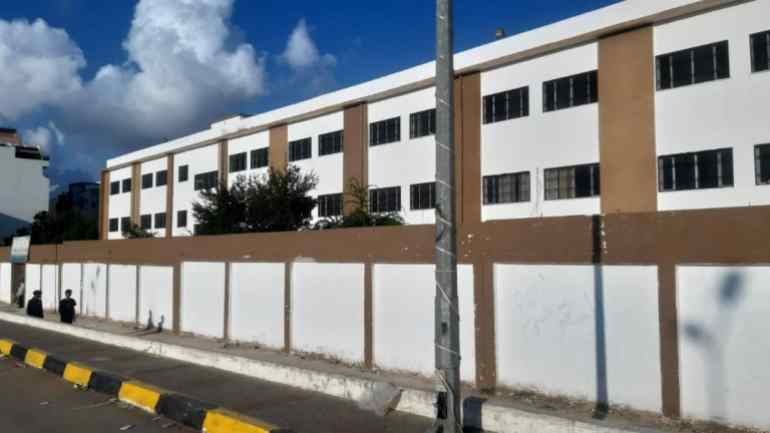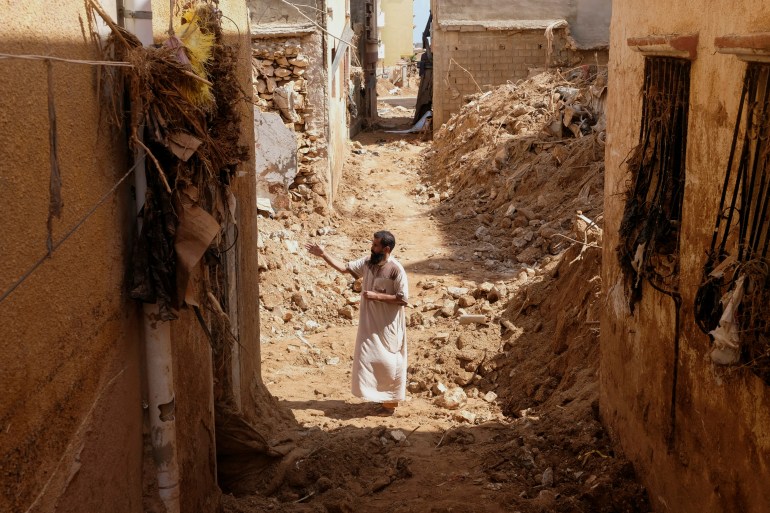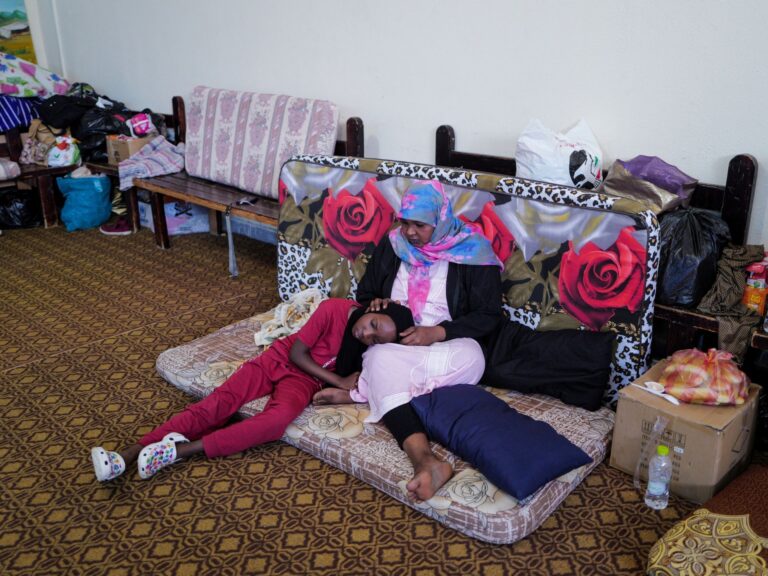Khadijah usually hears screaming in the midst of the night time.
It might be the girl within the subsequent classroom who has refused to take off her abaya since lethal floods hit Libya on September 10. She fears extra floods are coming and needs to stay hidden from them, believing her flowing robes will defend her, Khadijah, 60, mentioned.
Or maybe it is among the many who noticed their mom, father, little one or grandparent plunged into the ocean when the dams above the japanese metropolis of Derna burst, flooding it and its sleeping inhabitants.
“The dwelling are those that endure; the lifeless are relieved,” Khadijah instructed Al Jazeera.
Khadija is amongst hundreds of individuals from the flood-ravaged metropolis who’ve sought shelter in authorities faculties after their houses had been destroyed. She says she feels humiliated.
“Think about closing your eyes in entrance of your individual mattress and all of a sudden discovering your self on the chilly flooring of a public college,” she mentioned, wiping away tears.
“I’ve skilled most wars and disasters, [Muammar] Gaddafi’s siege of the town within the Nineties, by ISIS [ISIL] conflict in 2016, and the conflict of [Khalifa] Haftar’s forces in 2018, however what occurred now was totally different [and] what got here subsequent was extra humiliating,” she added solemnly.
Khadija, her kin, the 20 or so different households on the college they shelter, and the lots of sheltering elsewhere, at the moment are “local weather refugees,” the colloquial time period used for these displaced by environmental disasters.

However Derna itself was a haven for hundreds of migrants from neighboring nations, along with Libya’s personal internally displaced inhabitants who settled within the coastal metropolis from different components of the nation.
Whereas the explanations they’ve fled fluctuate, climate-induced pressures are exacerbated by elements reminiscent of battle and poverty, a posh net that’s fueling displacement within the area and can solely proceed within the coming years, consultants say.
Pushed out slowly – or all of a sudden
Khadija and different Libyans from Derna are entangled on this advanced net, however the stage was already set for the catastrophe that engulfed their houses and family members.
In accordance with the World Climate Attribution group, Storm Daniel was as much as 50 instances extra possible and 50 % extra intense on account of human-induced local weather change.
Ailing, poorly managed dams had been additionally a key issue.
“That is truly not potential [overstated] how essential the infrastructure challenge is, as a result of that is among the essential catalysts for local weather change,” Benjamin Freedman, an analyst on the Center East Institute, instructed Al Jazeera.
The failing dams, together with migrants “who weren’t essentially correctly settled,” created the “excellent storm for an outrageous humanitarian catastrophe,” he added.
Though the flash flood all of a sudden prompted survivors to flee, most individuals who depart their nations for environmental causes achieve this due to “slow-onset situations” reminiscent of extended droughts, mentioned Aimee-Noel Mbiyozo, a senior analysis adviser on the Institute. for safety research, Al Jazeera instructed.
Earlier than the floods, Libya was host to greater than 705,000 refugees and migrants of greater than 44 nationalities, based on Michela Pugliese, a migration and asylum researcher at Euro-Med Human Rights Monitor.
Greater than 230,000 of those refugees and migrants lived in japanese Libya, the a part of the nation devastated by the storm. The bulk got here from neighboring nations reminiscent of Chad, Egypt, Niger, Nigeria and Sudan, she added.
About 8,000 of them lived particularly in Derna, however it’s possible that many others had been current and never formally reported, Pugliese mentioned.
Whereas the explanations they ended up in Libya diversified – many hoped to finally depart for Europe – some left their houses on account of misplaced livelihoods on account of local weather disasters.
“There are lots of people coming [to] Libya from Chad, Sudan and Niger labored within the agricultural sector at house and got here to Libya after dropping crops or livestock on account of local weather occasions reminiscent of drought or floods,” Pugliese mentioned.

Worldwide regulation doesn’t acknowledge local weather refugees
It’s difficult to differentiate how lots of the 8,000 refugees in Derna had been local weather refugees, and what number of Libyans have now turn into local weather refugees on account of the floods – largely as a result of that time period doesn’t exist in worldwide regulation.
“This time period doesn’t but have a authorized foundation underneath refugee regulation, together with the UNHCR [the UN refugee agency] neither registering asylum seekers nor authorized companies helping migrants would use this as an official class,” Pugliese mentioned.
Mbiyozo added that individuals who transfer for climate-related causes hardly ever determine it as such.
“We ask folks why you moved and so they nearly by no means say ‘local weather change,’” she mentioned.
“They are going to inform you that is to seek out higher financial alternatives, in order that they transfer for jobs or for a dwelling. However then it’s important to go one degree deeper and say, “Nicely, what has modified?”
In West Africa, for instance, a refugee could flee Boko Haram as a result of the armed group has taken their livestock due to dwindling assets, she mentioned.
Local weather change within the context of migration is subsequently an “amplifier of vulnerability or an amplifier of threats,” mentioned Mbiyozo.
Freedman mentioned that as local weather disasters turn into extra widespread, there must be a system in place to determine folks displaced by these disasters.
When these teams of individuals attempt to apply for asylum particularly in Western nations, they’re denied at a lot larger charges because of the arbitrariness of the class, he mentioned.
However the scenario will solely proceed to worsen, “particularly as we face probably 1.2 billion folks internally and externally displaced by the intensification of local weather climate occasions by 2050,” Freedman added.
Nonetheless, Mbiyozo argued that if the legal guidelines had been rewritten, particularly the 1951 UN Refugee Conference, many Western nations would “withdraw what they’re at the moment providing”.
“Everybody within the refugee world is aware of intuitively that if you happen to had been to redraw these items, you’d get much less safety, as a result of that’s the political local weather proper now,” she mentioned, including that Italy, for instance, is attempting to show away as many asylum seekers because the nation does. can.

‘Nothing however guarantees’
Regardless of Western nations’ reluctance to simply accept new classes of refugees, consultants say most climate-related actions stay native, with many transferring from rural areas to city cities.
Among the many 40,000 folks displaced by the floods in Libya, many moved to cities and villages additional east and lots of to the west, Pugliese mentioned.
Amongst them are additionally the ‘twice displaced individuals’, who had been pushed from their nation to Libya after which pushed elsewhere once more from Derna.
“It’s nonetheless far too early to say what is going to occur [these displaced peoples]because the response for now continues to be purely humanitarian,” Pugliese mentioned.
Again in Derna, Khadijah is decided that she and her household can not keep on the college for much longer.
She pulled one in all her granddaughters shut and requested, “What is that this kid’s fault? Youngsters her age are finding out in faculties, and he or she lives right here.”
Some ladies on the college are hesitant to go to the lavatory due to privateness considerations, and the school rooms are freezing at night time though winter has but to reach, Khadijah mentioned.
She says she has “seen nothing however guarantees from the federal government.”
“We reside in an actual hell,” Khadijah mentioned.


